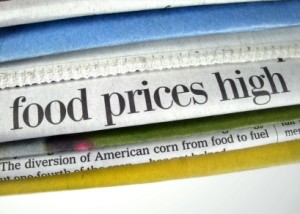Last week, the United States government released a report that showed less-than-expected grain reserves, with less acreage devoted to soybean and wheat crops. This  report only exacerbated concerns over the global grain supplies and saw an uptick in U.S. and European grain futures, particularly soybeans, which saw a 6 percent increase in price from February to March. The first quarter of 2012 saw a 17 percent increase in soybean futures.
report only exacerbated concerns over the global grain supplies and saw an uptick in U.S. and European grain futures, particularly soybeans, which saw a 6 percent increase in price from February to March. The first quarter of 2012 saw a 17 percent increase in soybean futures.
Corn and soybeans are set to be the dominant force on world grain markets, and rising soybean futures have some economists concerned farmers will trend toward that commodity over corn, increasing grain shortages.
The price of crude isn’t helping matters. “The food price index has an extremely high correlation to oil prices and with oil prices up, it’s going to be difficult for food prices not to follow suit,” said Nick Higgins, commodity analyst at Rabobank International.
The cost of fertilizers, farm machinery use, and market transportation costs are all related to the price of oil. This cost is also driving the price of food on grocery store shelves. 2011 saw a 26 percent increase in the price of groceries from oil alone.
Manufacturers have used marketing ploys such as smaller containers and less product to mask this upward trend in food prices, but there is only so far you can shrink the weight and packaging of a product before consumers connect the dots.
Weather changes in major producing countries will also have an affect on prices as areas cope with traditional El Nino climate patterns warming the Pacific Ocean or drought.
The USDA is forecasting a 3.5% to 4.5% increase this year for meats, poultry and fish, whose costs are climbing higher than overall food inflation in general. But inflation numbers are tricky to ascertain, especially since the government tinkers with them in order to push their feel-good propaganda measures. However, ask any housewife and she’ll tell you that her dollars go nowhere near as far as they used to do.
According to Stand Strong Research:
On average, our basic food costs have increased by an incredible 48% over the last year (measured by wheat, corn, oats, and canola prices). From the price at the pump to heating your stove, energy costs are up 23% on average (heating oil, gasoline, natural gas). A little protein at dinner is now 39% higher (beef and pork), and your morning cup of coffee with a little sugar has risen by 36% since last October.
 Off The Grid News Better Ideas For Off The Grid Living
Off The Grid News Better Ideas For Off The Grid Living



